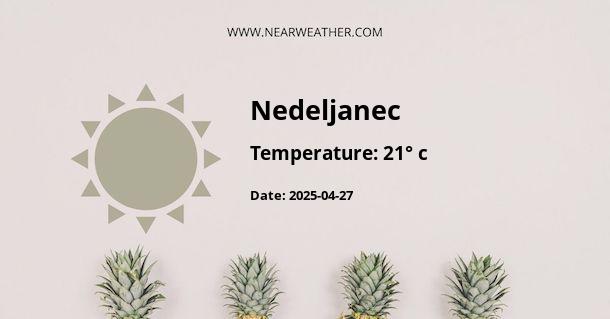Understanding the Climate and Weather of Nedeljanec, Croatia
Located in the northern part of Croatia, Nedeljanec is a place where the continental climate reigns supreme. This type of climate typically means that Nedeljanec experiences warm summers and cold winters, a characteristic climate for the interior of Croatia, away from the more Mediterranean influences along the Adriatic coast. Here, we'll delve into the specifics of Nedeljanec's climate, its weather patterns throughout the year, and what one can expect when visiting each season.
General Climate Overview
Nedeljanec, like much of northern Croatia, is subject to a humid continental climate, classified as Dfb according to the Köppen climate classification. This region is influenced by its inland position and relatively high altitude, which contribute to its significant seasonal temperature differences.
"The climate in Nedeljanec is characterized by its variability, with warm summers, cold winters, and transitional seasons that can be both capricious and charming." - Meteorological Institute of Croatia
Seasonal Weather Patterns
Spring (March-May)
- March: The onset of spring is a transition period, with snow melting, temperatures rising from an average low of 1°C to highs around 12°C by the end of the month, and a notable increase in precipitation.
- April: Temperatures continue to increase, with averages ranging from 6°C in the mornings to 18°C in the afternoons. Spring showers are common, and flora starts to bloom.
- May: May represents the full swing of spring, with temperatures now comfortably between lows of 10°C and highs touching 23°C. Precipitation continues with occasional thunderstorms.
Summer (June-August)
- June: As summer sets in, temperatures continually climb, averaging between lows of 15°C and highs around 27°C. This month also sees the longest days of the year.
- July: July is typically the warmest month, with average high temperatures peaking at about 29°C and only occasionally breaching 30°C. Nights remain pleasant around 16°C on average.
- August: The end of summer starts to see a gradual decline in temperatures with similar conditions to July; however, the frequency of thunderstorms may increase.
Autumn (September-November)
- September: Daytime highs begin to cool, averaging 24°C, while the nights start to draw in with lows around 11°C. The natural landscape transforms with vibrant autumnal colors.
- October: A more drastic drop in temperature occurs, with a range between 6°C at night and 17°C during the day, and winds pick up as the season progresses.
- November: Temperatures continue to fall, ranging now from 1°C to 10°C, signaling the approach of winter. Precipitation increases and may transition to snow towards the month's end.
Winter (December-February)
- December: Cold temperatures set in, with averages ranging from a low of -3°C to highs around 4°C. Snowfall is possible and becomes more likely as winter progresses.
- January: The coldest month of the year with average lows around -5°C, highs rarely exceed 3°C. Snow cover is common, and the weather can be quite harsh.
- February: While still cold, with a slight increase in daily highs and lows, February signals the impending end of winter. Snow and frost are still prevalent.
Annual Weather Statistics
| Month | Average High (°C) | Average Low (°C) | Precipitation (mm) | Snowfall (days) |
|---|---|---|---|---|
| January | 3 | -5 | 34 | 12 |
| February | 5 | -3 | 30 | 10 |
| March | 12 | 1 | 40 | 6 |
| April | 18 | 6 | 50 | 3 |
| May | 23 | 10 | 60 | 0 |
| June | 27 | 15 | 75 | 0 |
| July | 29 | 16 | 80 | 0 |
| August | 28 | 15 | 80 | 0 |
| September | 24 | 11 | 70 | 0 |
| October | 17 | 6 | 85 | 1 |
| November | 10 | 1 | 80 | 4 |
| December | 4 | -3 | 50 | 9 |
Extreme Weather and Climate Events
Nedeljanec, with its continental climate, can occasionally face extreme weather in the form of heatwaves during the summer and deep freezes in the winter. Such extreme temperature fluctuations can significantly impact agriculture, water supply, and heating demands. In addition, heavy snowfalls can disrupt transportation and infrastructure, necessitating efficient snow removal systems and emergency response strategies. The region is also susceptible to thunderstorms and hail during the transitional seasons, particularly in spring and autumn, which can present challenges for both residents and visitors alike.
Climatic Influences
Geographical factors such as the distance from the Adriatic Sea and the protection offered by the Alpine and Dinaric mountain ranges contribute to Nedeljanec's more continental climate profile. Prevailing winds from the northwest, known as the Bura, can lower temperatures and often bring clearer skies, while the southeastern Jugo wind is associated with humid and warmer conditions.
Recommendations for Travelers
When planning a visit to Nedeljanec, it is critical to consider the season. For those looking to enjoy outdoor activities in warm weather, the best time would be between late May and early September. If interested in winter sports or enjoying the snowy landscapes, late December through February are ideal months. Always bring layers of clothing to adapt to the variable temperatures, which can change notably from day to night.
Conclusion
Understanding and preparing for the weather and climate are essential considerations when living in or visiting Nedeljanec, Croatia. All four seasons bring distinct patterns and potential extremes, and awareness of these can lead to a more enjoyable and safer experience in this vibrant continental climate.
A - Nedeljanec's Latitude is 46.287781 & Longitude is 16.283331.
A - Weather in Nedeljanec is 21° today.
A - Climate Conditions in Nedeljanec shows few clouds today.
A - Humidity in Nedeljanec is 20% today.
A - Wind speed in Nedeljanec is 10.66 km/h, flowing at 85° wind direction. today.
